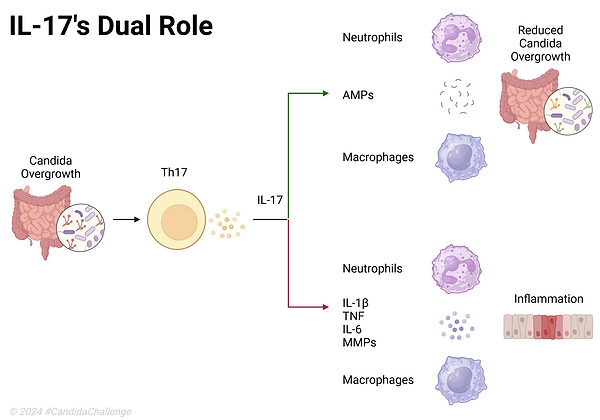Interleukin-17 Subhypothesis

Interleukin-17 Subhypothesis
The IL-17 subhypothesis posits that the immune response to Candida albicans overgrowth, involving the production of the cytokine IL-17 by T helper 17 (Th17) cells (Hernández-Santos and Gaffen 2012), significantly contributes to the pathogenesis of various chronic inflammatory diseases (Bedoya et al. 2013). A growing body of evidence highlights IL-17's crucial role in both antifungal immunity and inflammatory processes (Costa, Mattana, and da Silva 2010; Maddur et al. 2012; Bedoya et al. 2013; Conti and Gaffen 2015; Amatya, Garg, and Gaffen 2017; Veldhoen 2017; Zwicky, Unger, and Becher 2019; McGeachy, Cua, and Gaffen 2019; Ho et al. 2021; Mills 2023).
Role of IL-17 in Immune Response
IL-17, primarily produced by Th17 cells, is pivotal in defending against fungal pathogens like Candida albicans (Hernández-Santos and Gaffen 2012; Gow et al. 2012). When Candida albicans is present, it triggers IL-17 production, which recruits neutrophils and induces antimicrobial peptides to protect mucosal surfaces (Gow et al. 2012; Conti and Gaffen 2015). This immune response is essential for maintaining mucosal integrity and preventing systemic infections, underscoring IL-17's fundamental role in antifungal defense (Mills 2023).
Cross-Reactivity and Autoimmune Diseases
A critical aspect of the IL-17 subhypothesis is immune cross-reactivity, wherein responses against Candida albicans antigens inadvertently target host tissues with similar structures, potentially triggering autoimmune reactions (Vojdani et al. 1996; Maddur et al. 2012; Conti and Gaffen 2015). Studies reveal that anti-Candida antibodies can cross-react with tissue antigens (Bacher et al. 2019). This cross-reactivity leads to chronic activation of Th17 cells and sustained IL-17 production, resulting in persistent inflammation and tissue damage characteristic of autoimmune diseases (Bedoya et al. 2013).
IL-17 in Chronic Inflammatory Diseases
Elevated IL-17 levels have been documented in several chronic inflammatory and autoimmune diseases (Huangfu et al. 2023; Mills 2023), including Crohn's disease (Sarra et al. 2010; Fujino et al. 2003), multiple sclerosis (Milovanovic et al. 2020), myasthenia gravis (Aguilo-Seara et al. 2017; Roche et al. 2011), endometriosis (Shi et al. 2022; Sisnett et al. 2024), and psoriasis (El Sayed and Kabbani 2022). These elevated levels often correlate with disease severity, suggesting that IL-17 may play a central role in these conditions' inflammatory processes (Ruiz de Morales et al. 2020). For example, in Crohn's disease, IL-17 could contribute to chronic intestinal inflammation by promoting the recruitment of neutrophils and other immune cells to the gut, exacerbating tissue damage and inflammation.
Impact of IL-17 Inhibitors
The use of IL-17 inhibitors has provided valuable insights into the cytokine's role in disease. These inhibitors have shown efficacy in treating autoimmune conditions like psoriasis, illustrating IL-17's involvement in disease pathogenesis (Ghoreschi et al. 2021). However, IL-17 inhibitor treatment has also been linked to increased susceptibility to candidiasis (Bilal et al. 2024; Davidson et al. 2022), highlighting IL-17's crucial function in antifungal. This paradox underscores IL-17's dual role in maintaining immune balance: pivotal for fungal defense but also a driver of chronic inflammation when dysregulated (Amatya, Garg, and Gaffen 2017).
Conclusion
The IL-17 subhypothesis integrates immunological, microbiological, and clinical research findings, proposing a critical link between Candida albicans overgrowth and chronic inflammatory diseases. IL-17 mediates the immune response to fungal infections while potentially driving autoimmune processes through cross-reactivity. Further clinical trials and mechanistic studies are essential to comprehensively validate this subhypothesis and explore effective treatments for chronic inflammatory diseases.
Illustration created with BioRender